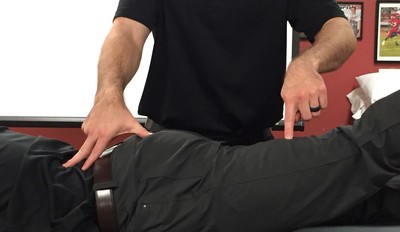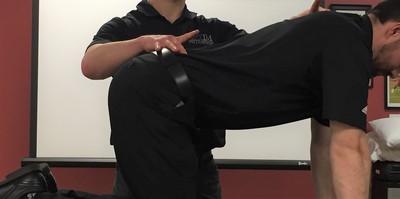- Home
- About Us
- TSPT Academy
- Online Courses
-
Resources
- Newsletter
- Business Minded Sports Physio Podcast
- Day in the Life of a Sports PT
- Residency Corner
-
Special Tests
>
-
Cervical Spine
>
- Alar Ligament Test
- Bakody's Sign
- Cervical Distraction Test
- Cervical Rotation Lateral Flexion Test
- Craniocervical Flexion Test (CCFT)
- Deep Neck Flexor Endurance Test
- Posterior-Anterior Segmental Mobility
- Segmental Mobility
- Sharp-Purser Test
- Spurling's Maneuver
- Transverse Ligament Test
- ULNT - Median
- ULNT - Radial
- ULNT - Ulnar
- Vertebral Artery Test
- Thoracic Spine >
-
Lumbar Spine/Sacroiliac Joint
>
- Active Sit-Up Test
- Alternate Gillet Test
- Crossed Straight Leg Raise Test
- Extensor Endurance Test
- FABER Test
- Fortin's Sign
- Gaenslen Test
- Gillet Test
- Gower's Sign
- Lumbar Quadrant Test
- POSH Test
- Posteroanterior Mobility
- Prone Knee Bend Test
- Prone Instability Test
- Resisted Abduction Test
- Sacral Clearing Test
- Seated Forward Flexion Test
- SIJ Compression/Distraction Test
- Slump Test
- Sphinx Test
- Spine Rotators & Multifidus Test
- Squish Test
- Standing Forward Flexion Test
- Straight Leg Raise Test
- Supine to Long Sit Test
-
Shoulder
>
- Active Compression Test
- Anterior Apprehension
- Biceps Load Test II
- Drop Arm Sign
- External Rotation Lag Sign
- Hawkins-Kennedy Impingement Sign
- Horizontal Adduction Test
- Internal Rotation Lag Sign
- Jobe Test
- Ludington's Test
- Neer Test
- Painful Arc Sign
- Pronated Load Test
- Resisted Supination External Rotation Test
- Speed's Test
- Posterior Apprehension
- Sulcus Sign
- Thoracic Outlet Tests >
- Yergason's Test
- Elbow >
- Wrist/Hand >
- Hip >
- Knee >
- Foot/Ankle >
-
Cervical Spine
>
- I want Financial Freedom
- I want Professional Growth
- I want Clinical Mastery
Dial Test
Purpose: To assess for laxity of the anterior hip capsule and iliofemoral ligament.
Test Position: Supine.
Performing the Test: Passively roll the leg into full medial and lateral rotation. The test is considered positive if range of motion is greater than 45 degrees and there is no rebound back to neutral.
Diagnostic Accuracy: Unknown specifically, but low evidence.
Importance of Test: The iliofemoral ligament attaches around the AIIS and acetabulum proximally and to the intertrochanteric line distally. With external rotation of the hip in neutral, the iliofemoral ligament and anterior capsule are the limiting structures and are, therefore, being assessed (Neumann). With internal rotation, the end-feel can be assessed for the ischiofemoral ligamanet and external rotator muscles as well. Due to the physical properties of collagen in the ligament and capsule, there is a spring-like aspect to the tissue that has some bounce to it, as long as the tissues are not overstretched, and, thus, lax. This test's results can be more accurate when combined with the results of long-axis femoral distraction, when assessing for laxity.
Note: these tests should only be used by properly trained health care practitioners.
Test Position: Supine.
Performing the Test: Passively roll the leg into full medial and lateral rotation. The test is considered positive if range of motion is greater than 45 degrees and there is no rebound back to neutral.
Diagnostic Accuracy: Unknown specifically, but low evidence.
Importance of Test: The iliofemoral ligament attaches around the AIIS and acetabulum proximally and to the intertrochanteric line distally. With external rotation of the hip in neutral, the iliofemoral ligament and anterior capsule are the limiting structures and are, therefore, being assessed (Neumann). With internal rotation, the end-feel can be assessed for the ischiofemoral ligamanet and external rotator muscles as well. Due to the physical properties of collagen in the ligament and capsule, there is a spring-like aspect to the tissue that has some bounce to it, as long as the tissues are not overstretched, and, thus, lax. This test's results can be more accurate when combined with the results of long-axis femoral distraction, when assessing for laxity.
Note: these tests should only be used by properly trained health care practitioners.
References:
Neumann, Donald. Kinesiology of the Musculoskeletal System: Foundations for Rehabilitation. 2nd edition. St. Louis, MO: Mosby Elsevier, 2010. 474-475. Print.
Neumann, Donald. Kinesiology of the Musculoskeletal System: Foundations for Rehabilitation. 2nd edition. St. Louis, MO: Mosby Elsevier, 2010. 474-475. Print.
Copyright © The Student Physical Therapist LLC 2023




